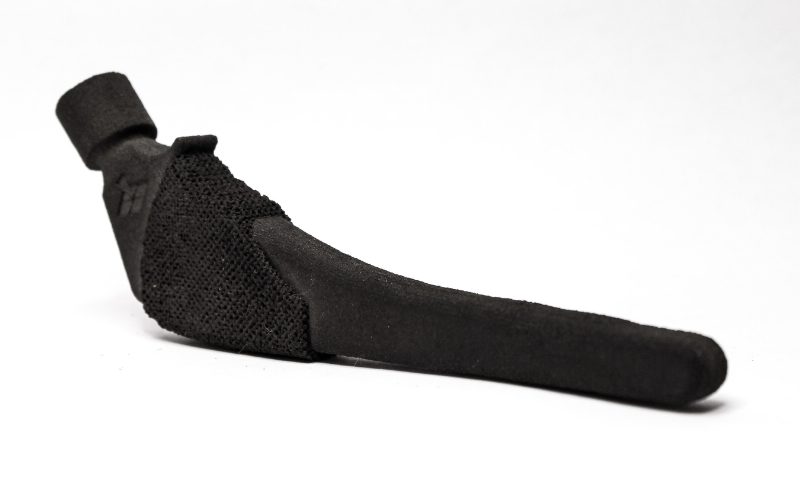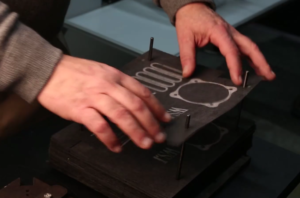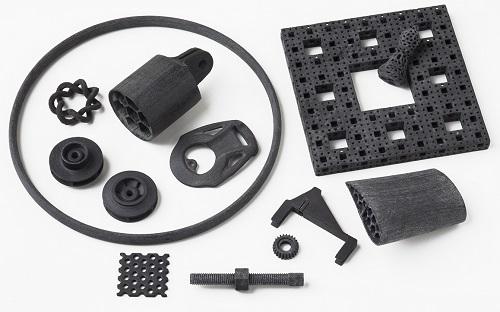 This week Illinois-based 3D printing materials sciences company Impossible Objects announced that they have developed a method of using PEEK (polyetheretherketone) with their revolutionary Composite-Based Additive Manufacturing (CBAM) process. For the first time the high-performance thermoplastic PEEK can be 3D printed to make durable, lightweight and geometrically complex carbon fiber composite parts. Because PEEK offers exceptional strength along with superior heat and chemical resistance, Impossible Objects is now capable of producing parts for applications that previously were virtually impossible. Industries as diverse as aerospace, medical, automotive and machine tooling will have access to a material that offers properties typically only found in metals.
This week Illinois-based 3D printing materials sciences company Impossible Objects announced that they have developed a method of using PEEK (polyetheretherketone) with their revolutionary Composite-Based Additive Manufacturing (CBAM) process. For the first time the high-performance thermoplastic PEEK can be 3D printed to make durable, lightweight and geometrically complex carbon fiber composite parts. Because PEEK offers exceptional strength along with superior heat and chemical resistance, Impossible Objects is now capable of producing parts for applications that previously were virtually impossible. Industries as diverse as aerospace, medical, automotive and machine tooling will have access to a material that offers properties typically only found in metals.
Parts that are produced using PEEK with the CBAM process have been thoroughly tested and ended up performing extremely well. CBAM PEEK parts will perform more than 30% better than CBAM parts using traditional materials. The parts also have a tensile strength of 205 MPa (29,700 psi) with an impressive heat resistance of 250°C (482°F). Combined with the freedom of virtually unlimited geometry and fast production times that are offered with the CBAM process, carbon fiber-PEEK composite parts can be used in the place of many heavier and more limited metal parts.
“Plastic-based 3D printing has not been able to compete with metals because of temperature resistance and strength. Now we can produce parts that begin to compete with metals in these areas, while having better strength-to-weight ratios than some metals. Our mission is to bring 3D printing into the mainstream of higher volume, lightweight, high-performance part manufacturing. Adding PEEK to our roster of printable materials is a major step toward that goal,” explained Impossible Objects CEO Larry Kaplan.
The CBAM process developed by Impossible Objects is the first truly new 3D printing technology that has been developed in more than 20 years. CBAM uses conventional thermal inkjet heads to print individual layers on sheets of composite materials, including carbon fiber, Kevlar or fiberglass. The sheet is then coated with powdered polymers like nylon or PEEK, which sticks to the still-wet pattern printed in inkjet fluids. Just as with a 2D printer or copier, each layer of the 3D object is printed off individually. Once the excess powder materials are vacuumed off, the sheets are stacked in order before being compressed and heated until the powder melts, which binds the patterns together to form a fully-solid part.
- Each layer is printed on individual sheets.
- The sheets are stacked together.
- The sheets are compressed and heated until the part is formed.
Once all of the layers have been successfully bonded together, the remainder of the sheets of carbon fiber are removed, either with sandblasting or chemical treatments. The remaining part offers strong and lightweight properties that are impossible to manufacture as quickly and inexpensively. Because the final parts match the strength-to-weight ratio of many common industrial-use metals, the process is ideal for applications that have critical weight and durability requirements as well as a need for air- and water-tight features. Industries like aerospace, aviation, automotive, defense, oilfield services and performance athletics will especially benefit from this new 3D printing process and advanced materials. You can see video of the process here.
“These advances of speed and material properties will allow additive manufacturing to change how things are made. Our focus on making functional parts, not just prototypes, stems from our proprietary materials sciences breakthroughs, which provide our process with advantages over other 3D approaches, including strength and speed. Our long-term goal is to compete with machining and injection molding. We have a multi-year roadmap to realize additively manufactured parts on par with those made through traditional manufacturing methods, such as injection molding, machining and die-casting,” said the chairman and founder of Impossible Objects, Robert Swartz.
CBAM parts made with PEEK are up to 10 times stronger and can be manufactured up to 100 times faster than traditional methods. Standard CBAM parts made with carbon fiber or nylon have a tensile strength of 150 MPa (21,700 psi) with a heat resistance of 120°C (248°F). Alternately, CBAM parts made with PEEK perform more than 30% better, have a tensile strength of 205 MPa (29,700 psi) with a heat resistance of 250°C (482°F). They are also more than 50% lighter than traditional aluminum parts while maintaining 2/3rds of the strength. The PEEK composite materials are also recyclable. You can find out how to order 3D printed carbon fiber composite PEEK parts from Impossible Objects here. Discuss further over in the 3D Printed PEEK forum at 3DPB.com.
Subscribe to Our Email Newsletter
Stay up-to-date on all the latest news from the 3D printing industry and receive information and offers from third party vendors.
You May Also Like
3D Printing Financials: Fathom Struggles in Financial Quicksand During Critical Transition
Facing a year of key transitions and financial pressures, Fathom (Nasdaq: FTHM) has filed its annual report for 2023 with the U.S. Securities and Exchange Commission (SEC). The document outlines...
Latest Earnings Overview for Australian 3D Printing Firms Titomic and AML3D
Australian 3D printing manufacturing firms Titomic (ASX: TTT) and AML3D (ASX: AL3) reported their financial results for the period from July to December 2023, marking the first half of their...
3D Printing Webinar and Event Roundup: April 7, 2024
Webinars and events in the 3D printing industry are picking back up this week! Sea-Air-Space is coming to Maryland, and SAE International is sponsoring a 3D Systems webinar about 3D...
3D Printing Financials: Unpacking Farsoon and BLT’s 2023 Performance
In the Chinese 3D printing industry, two companies, Farsoon (SHA: 688433) and Bright Laser Technologies, or BLT (SHA: 688333), have recently unveiled their full-year earnings for 2023. Farsoon reported increases...




































